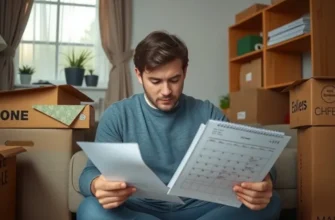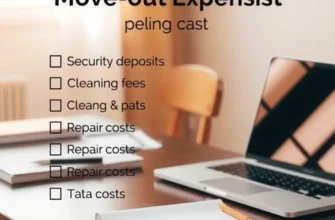Understanding security deposits is crucial for anyone entering the rental market, whether you’re a young professional, a student, a couple, or a family. These deposits, usually equal to one or two months’ rent, serve as a safeguard for landlords against potential damages or unpaid rent. However, navigating the rules, regulations, and intricacies of security deposits can be daunting. Each state has different guidelines on what landlords can ask for, how much they can charge, and the timelines for returning deposits after tenants move out. Familiarity with these aspects not only empowers you during your lease negotiation but also ensures financial clarity as you dive into this new chapter of renting. This guide aims to provide a straightforward overview of security deposits, helping first-time renters feel more informed and comfortable as they embark on their journey. Let’s unravel the details so you can manage your finances wisely and focus on making your new space feel like home.
Understanding Security Deposits: What to Expect

Security deposits are a fundamental aspect of renting property, serving as a financial safety net for landlords and a commitment from tenants. Grasping the role and nuances of these deposits can save you from future headaches.
Primarily, a security deposit is intended to cover any unpaid rent or damage to the property that exceeds normal wear and tear. Before signing a lease, ensure you are clear on what the deposit covers and any conditions for its partial or full retention by the landlord.
Typical Costs
The cost of security deposits usually ranges from one to three months’ rent. Factors like local regulations and rental market conditions can influence this amount. Research your local real estate market to understand what is reasonable. In some locations, laws cap the maximum allowable deposit, offering tenants some protection from excessive charges.
Before You Sign the Lease
Understanding your rights and responsibilities regarding security deposits is crucial before signing any rental agreements. Read the lease thoroughly and pay attention to clauses related to the deposit.
-
Documentation: Document the condition of the apartment before moving in. Take clear, dated photos of existing damages. This step is vital in ensuring you’re not held liable for pre-existing conditions. Refer to this resource on documenting damages for detailed guidance.
-
Ask Questions: Inquire about deposit return policies, potential deductions, and how disputes are handled. Clarify the timeline and process for getting your deposit back. Landlords generally have 14 to 60 days post-lease termination to return the deposit, depending on local laws.
-
Maintenance and Repairs: Confirm who is responsible for repairs during the tenancy. Some leases stipulate tenants handle minor repairs, which directly affects the potential deductions from your deposit.
Expect Transparent Communication
Insight into deposit allocation processes can prevent misunderstandings. Landlords are often required to provide an itemized statement of any deductions made from the deposit. This statement should break down costs for damage repairs or unpaid rent.
Finally, remember that a good relationship with your landlord can ease tensions if disputes arise. Practice open communication and uphold your end of the lease, maintaining the property in good condition.
Security deposits, while initially a financial burden, can be manageable and even beneficial when approached with knowledge and foresight. As you continue your rental journey, consider incorporating renter-friendly home improvements to enhance your living space without jeopardizing your deposit.
Navigating Security Deposit Returns: Your Rights and Responsibilities

Securing the return of your security deposit is a process that requires understanding both your tenant rights and responsibilities. Knowing the factors that can affect the return of your deposit can make a significant difference. Here’s how you can navigate this aspect of renting and ensure a smoother experience.
Common Deductions
One of the first steps in protecting your security deposit is to understand the potential deductions landlords might make. Common deductions include repairs for damages beyond normal wear and tear, unpaid rent, and excessive cleaning costs. A clear distinction between normal wear and tear versus actual damage can be one of the most challenging aspects of the process.
To prevent unnecessary charges, document the state of the apartment before you move in. Take detailed photos and notes, keeping a record of any existing damage. This documentation will be invaluable if you need to dispute deductions later.
Navigating State Laws
Security deposit laws differ significantly from state to state. Some states require landlords to return the deposit within a short window, often around 14 to 30 days after you vacate, while others allow more time. Check your state’s regulations to know exactly what your landlord is legally bound to do.
Some states have caps on how much security deposit a landlord can demand, and they may also require landlords to keep these deposits in separate interest-bearing accounts. Be sure to request a written statement outlining the condition of the property after you move out, as some states mandate this document to justify any deductions.
Tips for Ensuring Your Deposit’s Return
First, clear communication with your landlord is key. Notify them well in advance of your move-out date to schedule a walkthrough inspection, which gives you an opportunity to address any issues identified. This proactive step can often prevent disputes over the condition of the property.
Second, consider doing a deep cleaning after all your belongings have been removed. Pay attention to commonly missed areas such as behind appliances, inside closets, and window tracks. If hiring a professional cleaning service is feasible, it may save time and better ensure thoroughness.
Third, familiarize yourself with the documentation process. As discussed in this guide on documenting apartment damage, maintaining evidence of your circumstance and any correspondence with your landlord can be highly beneficial.
Finally, always leave a forwarding address and ensure open communication channels remain accessible. If there’s a dispute, try to resolve it amicably and directly with your landlord. However, if a resolution isn’t reached, you may need to seek advice from local tenant rights organizations or pursue the matter through small claims court.
Understanding these aspects of security deposits can help you navigate the return process with confidence. By being proactive and knowledgeable, you enhance your chances of a favorable outcome.
Final words
Navigating security deposits is a fundamental part of the rental experience that can seem overwhelming at first, but understanding your rights and responsibilities leads to a smoother process. Whether you’re a first-time renter or someone transitioning into a new living situation, knowledge gives you the power to protect your finances and ensure a positive renting experience. Be proactive, ask questions, and familiarize yourself with local laws to help you avoid common pitfalls. Remember, it’s not just about paying a deposit; it’s about setting a foundation for your future home. Armed with this understanding, you can confidently step forward into your rental journey.









